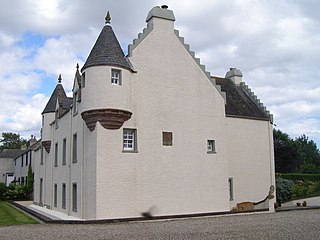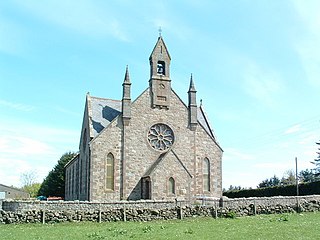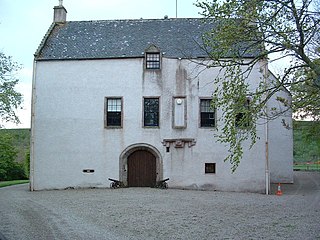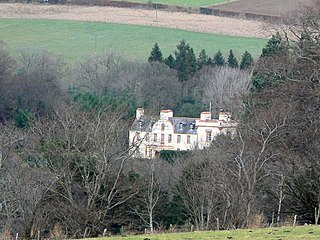
Castle Fraser is the most elaborate Z-plan castle in Scotland and one of the grandest 'Castles of Mar'. It is located near Kemnay in the Aberdeenshire region of Scotland. The castle stands in over 300 acres (1.2 km2) of landscaped grounds, woodland and farmland which includes a walled kitchen garden of the 19th century. There is archaeological evidence of an older square tower dating from around 1400 or 1500 within the current construction. The castle is a Category A listed building and the grounds are included in the Inventory of Gardens and Designed Landscapes in Scotland.

Drum Castle is a castle near Drumoak in Aberdeenshire, Scotland. For centuries it was the seat of the chief of Clan Irvine. The place-name Drum is derived from Gaelic druim, 'ridge'. The site is located approximately 6+1⁄2 miles northeast of Banchory and 3 miles west of Peterculter. The property is now owned by the National Trust for Scotland and is open to the public.

Crathes Castle is a castle, built in the 16th-century, near Banchory in Aberdeenshire, Scotland. It is in the historic county of Kincardineshire. This harled castle was built by the Burnetts of Leys and was owned by the family for almost 400 years. The castle and its grounds are currently owned and managed by the National Trust for Scotland and are open to the public.

Craigievar Castle is a pinkish harled castle or fortified country house 6 miles (9.7 km) south of Alford, Aberdeenshire, Scotland. It was the seat of Clan Sempill and the Forbes family resided here for 350 years until 1963, when the property was given to the National Trust for Scotland by William Forbes-Sempill, 19th Lord Sempill. The setting is among scenic rolling foothills of the Grampian Mountains, and the contrast of its massive lower storey structure to the finely sculpted multiple turrets, gargoyles and high corbelling work to create a classic fairytale appearance.

Harling is a rough-cast wall finish consisting of lime and aggregate, known for its rough texture. Many castles and other buildings in Scotland and Ulster have walls finished with harling. It is also used on contemporary buildings, where it protects against the wet Scottish and Ulster climates and eliminates the need for paint.

Clan Gordon is a Highland Scottish clan, historically one of the most powerful Scottish clans. The Gordon lands once spanned a large territory across the Highlands. Presently, Gordon is seated at Aboyne Castle, Aberdeenshire. The Chief of the clan is the Earl of Huntly, later the Marquess of Huntly.

A great hall is the main room of a royal palace, castle or a large manor house or hall house in the Middle Ages, and continued to be built in the country houses of the 16th and early 17th centuries, although by then the family used the great chamber for eating and relaxing. At that time the word "great" simply meant big and had not acquired its modern connotations of excellence. In the medieval period, the room would simply have been referred to as the "hall" unless the building also had a secondary hall, but the term "great hall" has been predominant for surviving rooms of this type for several centuries, to distinguish them from the different type of hall found in post-medieval houses. Great halls were found especially in France, England and Scotland, but similar rooms were also found in some other European countries.

Muchalls Castle stands overlooking the North Sea in the countryside of Kincardine and Mearns, Aberdeenshire, Scotland. The lower course is a well-preserved Romanesque, double-groined 13th-century tower house structure, built by the Frasers of Muchalls. Upon this structure, the 17th-century castle was begun by Alexander Burnett of Leys and completed by his son, Sir Thomas Burnett, 1st Baronet, in 1627. The Burnetts of Leys built the remaining four-storey present-day castle.

Monboddo House is a historically famous mansion in The Mearns, Scotland. The structure was generally associated with the Burnett of Leys family. The property itself was owned by the Barclay family from the 13th century, at which time a tower house structure was erected. In 1593, the Laird was James Strachan, and thence it passed into the Irvine family and thereafter the Burnetts of Leys. There is a notable datestone adornment on the structure with the arms of Irvine impaling the arms of Douglas with initials R.E. and I.E. and dated 1635, representing the 17th-century couple who reconstructed the house, Robert Ervine and Ilizabeth Ervine. Monboddo House, with its crow-stepped gable design, is situated in the Howe of Mearns near the village of Auchenblae approximately nine miles (14 km) from the North Sea. The original landholding of the Monboddo Estate was approximately 200 square kilometres (77 sq mi).

Fetteresso Castle is a 14th-century tower house, rebuilt in 1761 as a Scottish Gothic style Palladian manor, with clear evidence of prehistoric use of the site. It is situated immediately west of the town of Stonehaven in Kincardineshire, slightly to the west of the A90 dual carriageway. Other notable historic fortified houses or castles in this region are Dunnottar Castle, Muchalls Castle, Fiddes Castle, Cowie Castle and Monboddo House.

The House of Burnett is a Lowland and Border Scottish family composed of several branches. The Chief of the Name and Arms of Burnett is James Comyn Amherst Burnett of Leys.

Ury House is a large ruined mansion in Aberdeenshire, Scotland, built in the Elizabethan style in 1885 by Sir Alexander Baird, 1st Baronet. It is situated on the north-east coast about 1 mile (1.6 km) north of Stonehaven in the former county of Kincardineshire.
Sir Thomas Burnett of Leys, 3rd Baronet,, Lord Clerk Register, PC, MP. He was, at Stonehaven, 21 April 1664, retoured as heir to his father, Sir Alexander Burnett, 2nd Baronet who had died the previous year. The 3rd Baronet is the grandson of Sir Thomas Burnett, 1st Baronet, who completed the reconstruction of Muchalls Castle and the great-grandson of Alexander Burnett of Leys, who completed the construction of Crathes Castle.

Sir Thomas Burnett, 1st Baronet of Leys was a feudal baron and leading Covenanter who had represented Kincardineshire in the Scottish Parliament in 1621.

Cookney is a hamlet in Aberdeenshire, Scotland in proximity to Netherley in the Mounth of the Grampian Highlands. The community is situated on a hilltop approximately 5 miles (8 km) northwest of Stonehaven, about 3 miles (5 km) northwest of the Bridge of Muchalls, and about 2 miles (3 km) west of Muchalls Castle. From Cookney a portion of the ancient route of the Causey Mounth is visible to the east near Whinward Farm, although the track is not truly recognizable from that distance. The Cookney Church is a prominent historic landmark of Cookney.

Coy Burn is a stream that rises in the hills north of Banchory in Aberdeenshire, Scotland. Coy Burn discharges to the River Dee at Milton of Crathes.

Allardice Castle is a sixteenth-century manor house in Kincardineshire, Scotland. It is approximately 1.5 kilometres north-west of the town of Inverbervie. The Bervie Water flows around Allardice Castle on both sides. Allardice may be viewed as one of a chain of coastal castles; to the north are Dunnottar Castle (ruined), Fetteresso Castle, Cowie Castle (ruined) and Muchalls Castle. The castle is a category A listed building. Allardice castle was the chief seat of the Barons of Allardice, an ancient family who first appear in an 1197 charter. Since 1542 many alterations and changes have been made to the original structure.
Alexander Burnett may refer to:

Furniture and furnishings in early modern and late medieval Scotland were made locally or imported, mostly from Flanders and France. Although few pieces of furniture survive from the early part of the period, a rich vocabulary and typology is preserved in inventories and wills. This documentary evidence in the Scots language details the homes of the wealthy and aristocratic. Textiles and beds belonging to Mary, Queen of Scots are very well documented. Scottish wooden furniture was often carved with the initials of married couples.

James Crichton of Frendraught or Frendraucht was a Scottish landowner involved in a fire on 18 October 1630. Eight guests were killed at Frendraught Castle and arson was suspected. The facts of the case were widely disputed.

















